Report on Building a Sustainable Organization: Benefits and Attributes
VerifiedAdded on 2023/06/08
|6
|1315
|487
Report
AI Summary
This report delves into the concept of building a sustainable organization, emphasizing the integration of environmental, social, and economic considerations into business practices. It explores the definition of sustainability, focusing on its impact on long-term benefits for companies, such as increased uniqueness, customer value, and cost reduction through improved productivity. The report examines the attributes and capabilities essential for business success in a complex and changing environment, including operational, strategic, and dynamic capabilities. Real-world examples, such as Marks and Spencer and Tesco, illustrate how companies are implementing sustainable practices. The conclusion reinforces the growing importance of sustainability in organizational strategy, highlighting the competitive advantages it creates. The report is a comprehensive analysis of sustainable business practices, providing valuable insights for students and professionals alike.
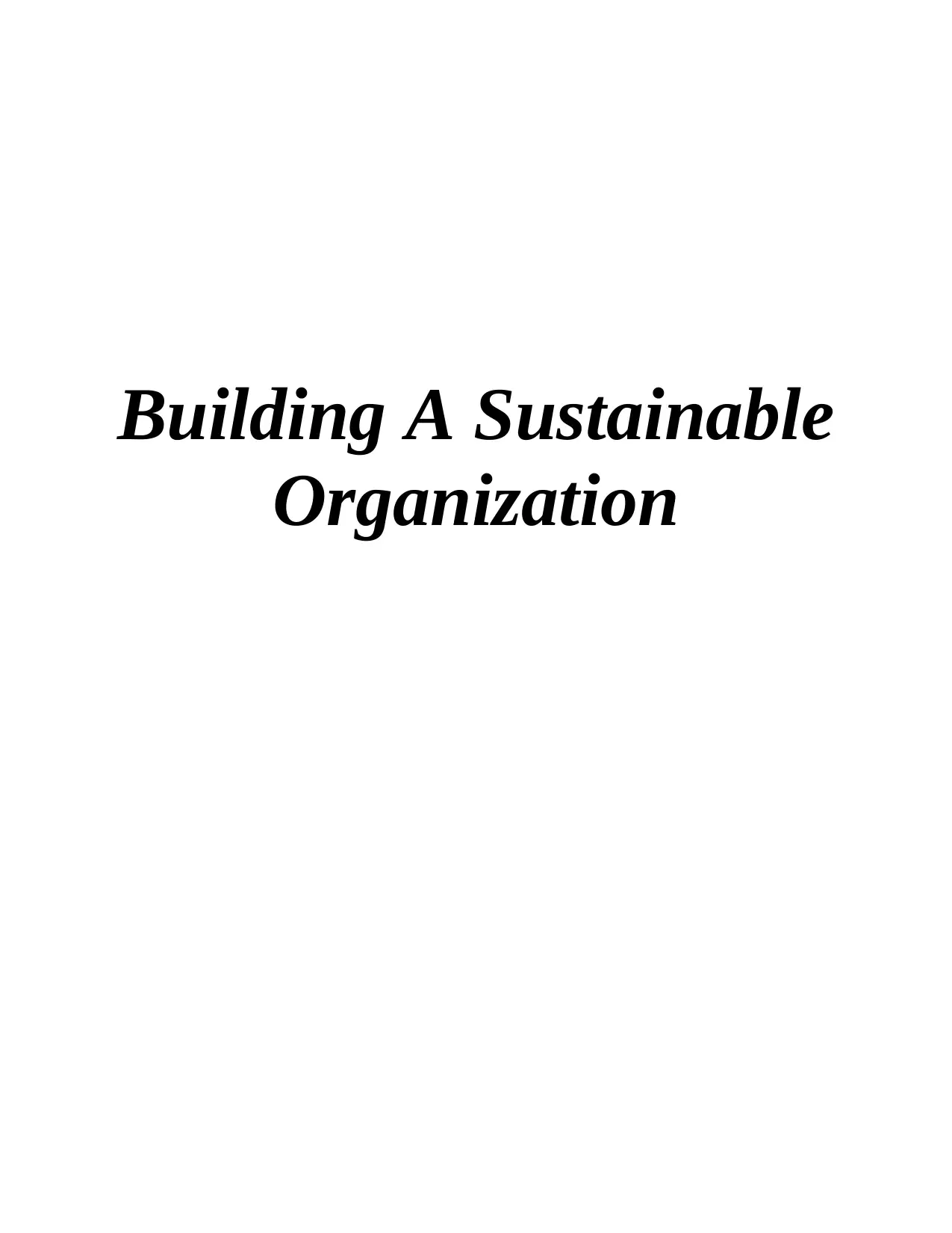
Building A Sustainable
Organization
Organization
Paraphrase This Document
Need a fresh take? Get an instant paraphrase of this document with our AI Paraphraser
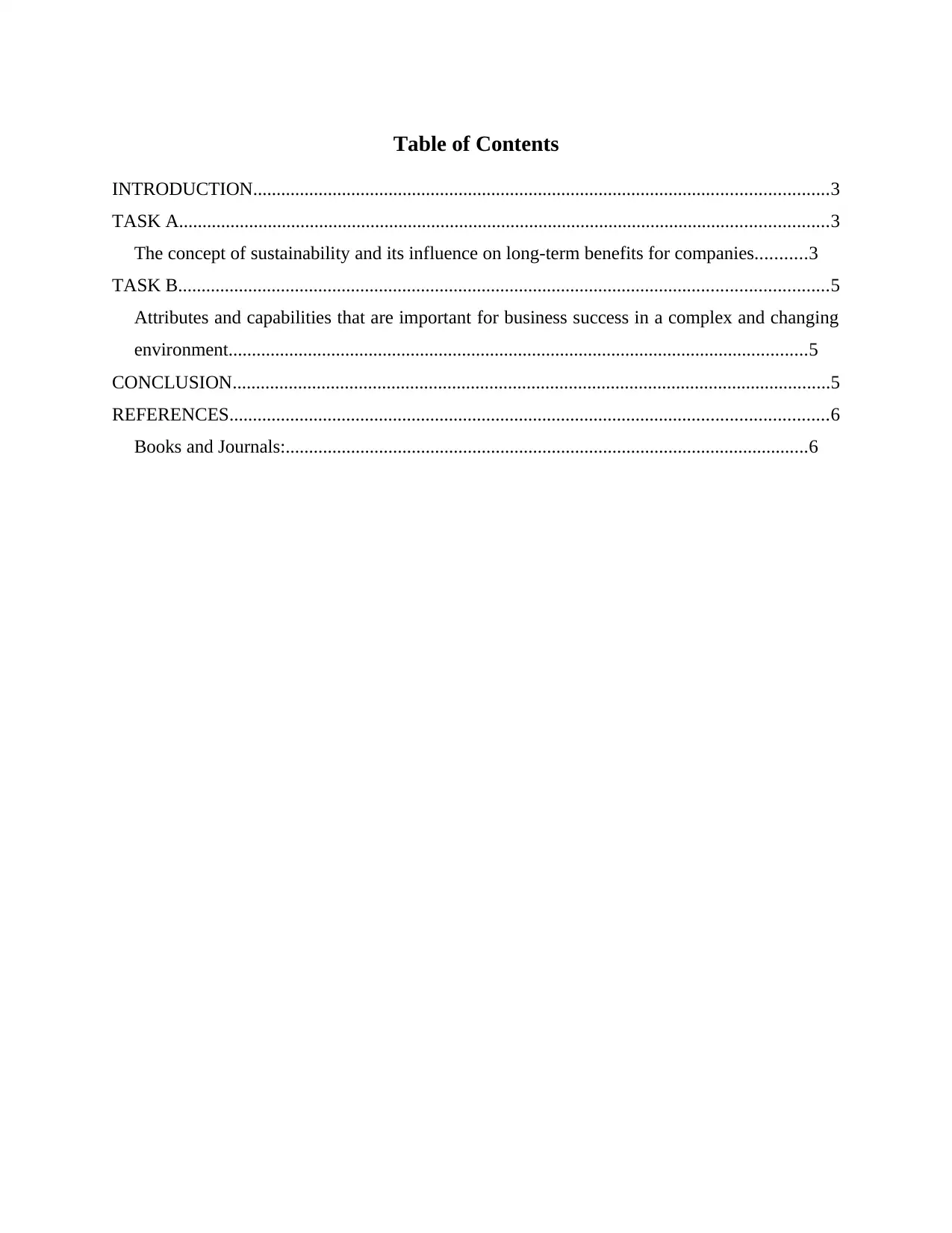
Table of Contents
INTRODUCTION...........................................................................................................................3
TASK A...........................................................................................................................................3
The concept of sustainability and its influence on long-term benefits for companies...........3
TASK B...........................................................................................................................................5
Attributes and capabilities that are important for business success in a complex and changing
environment............................................................................................................................5
CONCLUSION................................................................................................................................5
REFERENCES................................................................................................................................6
Books and Journals:................................................................................................................6
INTRODUCTION...........................................................................................................................3
TASK A...........................................................................................................................................3
The concept of sustainability and its influence on long-term benefits for companies...........3
TASK B...........................................................................................................................................5
Attributes and capabilities that are important for business success in a complex and changing
environment............................................................................................................................5
CONCLUSION................................................................................................................................5
REFERENCES................................................................................................................................6
Books and Journals:................................................................................................................6
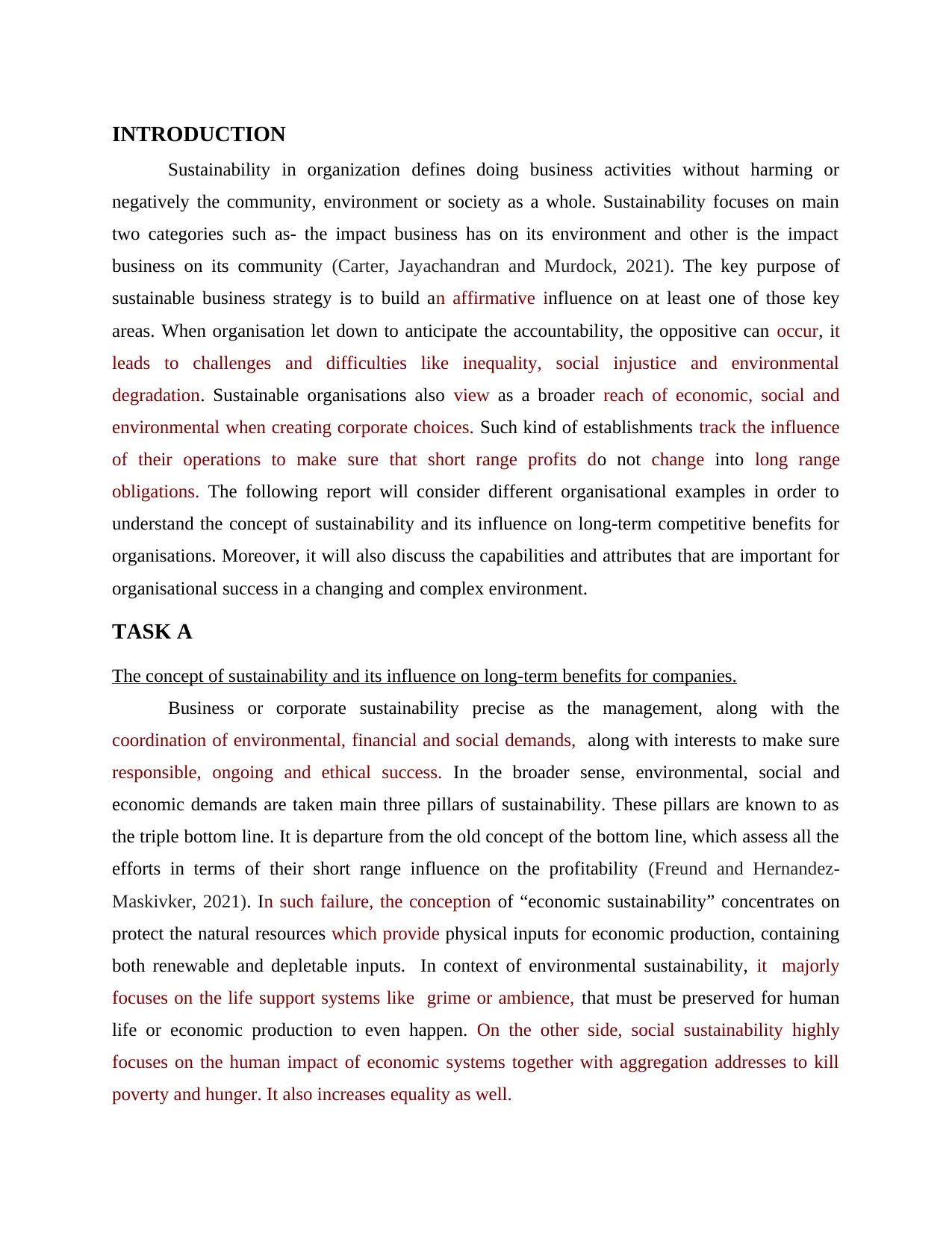
INTRODUCTION
Sustainability in organization defines doing business activities without harming or
negatively the community, environment or society as a whole. Sustainability focuses on main
two categories such as- the impact business has on its environment and other is the impact
business on its community (Carter, Jayachandran and Murdock, 2021). The key purpose of
sustainable business strategy is to build an affirmative influence on at least one of those key
areas. When organisation let down to anticipate the accountability, the oppositive can occur, it
leads to challenges and difficulties like inequality, social injustice and environmental
degradation. Sustainable organisations also view as a broader reach of economic, social and
environmental when creating corporate choices. Such kind of establishments track the influence
of their operations to make sure that short range profits do not change into long range
obligations. The following report will consider different organisational examples in order to
understand the concept of sustainability and its influence on long-term competitive benefits for
organisations. Moreover, it will also discuss the capabilities and attributes that are important for
organisational success in a changing and complex environment.
TASK A
The concept of sustainability and its influence on long-term benefits for companies.
Business or corporate sustainability precise as the management, along with the
coordination of environmental, financial and social demands, along with interests to make sure
responsible, ongoing and ethical success. In the broader sense, environmental, social and
economic demands are taken main three pillars of sustainability. These pillars are known to as
the triple bottom line. It is departure from the old concept of the bottom line, which assess all the
efforts in terms of their short range influence on the profitability (Freund and Hernandez-
Maskivker, 2021). In such failure, the conception of “economic sustainability” concentrates on
protect the natural resources which provide physical inputs for economic production, containing
both renewable and depletable inputs. In context of environmental sustainability, it majorly
focuses on the life support systems like grime or ambience, that must be preserved for human
life or economic production to even happen. On the other side, social sustainability highly
focuses on the human impact of economic systems together with aggregation addresses to kill
poverty and hunger. It also increases equality as well.
Sustainability in organization defines doing business activities without harming or
negatively the community, environment or society as a whole. Sustainability focuses on main
two categories such as- the impact business has on its environment and other is the impact
business on its community (Carter, Jayachandran and Murdock, 2021). The key purpose of
sustainable business strategy is to build an affirmative influence on at least one of those key
areas. When organisation let down to anticipate the accountability, the oppositive can occur, it
leads to challenges and difficulties like inequality, social injustice and environmental
degradation. Sustainable organisations also view as a broader reach of economic, social and
environmental when creating corporate choices. Such kind of establishments track the influence
of their operations to make sure that short range profits do not change into long range
obligations. The following report will consider different organisational examples in order to
understand the concept of sustainability and its influence on long-term competitive benefits for
organisations. Moreover, it will also discuss the capabilities and attributes that are important for
organisational success in a changing and complex environment.
TASK A
The concept of sustainability and its influence on long-term benefits for companies.
Business or corporate sustainability precise as the management, along with the
coordination of environmental, financial and social demands, along with interests to make sure
responsible, ongoing and ethical success. In the broader sense, environmental, social and
economic demands are taken main three pillars of sustainability. These pillars are known to as
the triple bottom line. It is departure from the old concept of the bottom line, which assess all the
efforts in terms of their short range influence on the profitability (Freund and Hernandez-
Maskivker, 2021). In such failure, the conception of “economic sustainability” concentrates on
protect the natural resources which provide physical inputs for economic production, containing
both renewable and depletable inputs. In context of environmental sustainability, it majorly
focuses on the life support systems like grime or ambience, that must be preserved for human
life or economic production to even happen. On the other side, social sustainability highly
focuses on the human impact of economic systems together with aggregation addresses to kill
poverty and hunger. It also increases equality as well.
⊘ This is a preview!⊘
Do you want full access?
Subscribe today to unlock all pages.

Trusted by 1+ million students worldwide
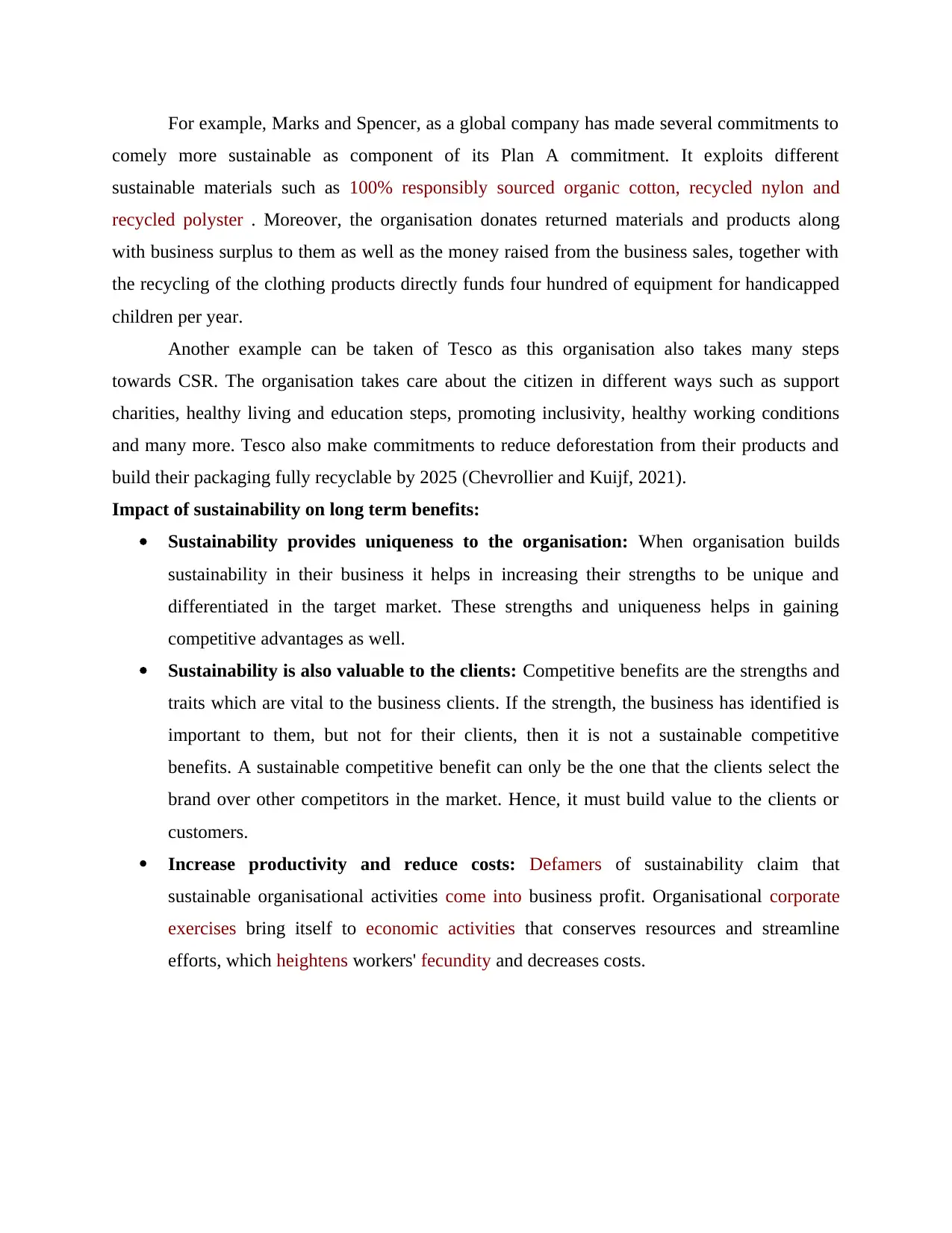
For example, Marks and Spencer, as a global company has made several commitments to
comely more sustainable as component of its Plan A commitment. It exploits different
sustainable materials such as 100% responsibly sourced organic cotton, recycled nylon and
recycled polyster . Moreover, the organisation donates returned materials and products along
with business surplus to them as well as the money raised from the business sales, together with
the recycling of the clothing products directly funds four hundred of equipment for handicapped
children per year.
Another example can be taken of Tesco as this organisation also takes many steps
towards CSR. The organisation takes care about the citizen in different ways such as support
charities, healthy living and education steps, promoting inclusivity, healthy working conditions
and many more. Tesco also make commitments to reduce deforestation from their products and
build their packaging fully recyclable by 2025 (Chevrollier and Kuijf, 2021).
Impact of sustainability on long term benefits:
Sustainability provides uniqueness to the organisation: When organisation builds
sustainability in their business it helps in increasing their strengths to be unique and
differentiated in the target market. These strengths and uniqueness helps in gaining
competitive advantages as well.
Sustainability is also valuable to the clients: Competitive benefits are the strengths and
traits which are vital to the business clients. If the strength, the business has identified is
important to them, but not for their clients, then it is not a sustainable competitive
benefits. A sustainable competitive benefit can only be the one that the clients select the
brand over other competitors in the market. Hence, it must build value to the clients or
customers.
Increase productivity and reduce costs: Defamers of sustainability claim that
sustainable organisational activities come into business profit. Organisational corporate
exercises bring itself to economic activities that conserves resources and streamline
efforts, which heightens workers' fecundity and decreases costs.
comely more sustainable as component of its Plan A commitment. It exploits different
sustainable materials such as 100% responsibly sourced organic cotton, recycled nylon and
recycled polyster . Moreover, the organisation donates returned materials and products along
with business surplus to them as well as the money raised from the business sales, together with
the recycling of the clothing products directly funds four hundred of equipment for handicapped
children per year.
Another example can be taken of Tesco as this organisation also takes many steps
towards CSR. The organisation takes care about the citizen in different ways such as support
charities, healthy living and education steps, promoting inclusivity, healthy working conditions
and many more. Tesco also make commitments to reduce deforestation from their products and
build their packaging fully recyclable by 2025 (Chevrollier and Kuijf, 2021).
Impact of sustainability on long term benefits:
Sustainability provides uniqueness to the organisation: When organisation builds
sustainability in their business it helps in increasing their strengths to be unique and
differentiated in the target market. These strengths and uniqueness helps in gaining
competitive advantages as well.
Sustainability is also valuable to the clients: Competitive benefits are the strengths and
traits which are vital to the business clients. If the strength, the business has identified is
important to them, but not for their clients, then it is not a sustainable competitive
benefits. A sustainable competitive benefit can only be the one that the clients select the
brand over other competitors in the market. Hence, it must build value to the clients or
customers.
Increase productivity and reduce costs: Defamers of sustainability claim that
sustainable organisational activities come into business profit. Organisational corporate
exercises bring itself to economic activities that conserves resources and streamline
efforts, which heightens workers' fecundity and decreases costs.
Paraphrase This Document
Need a fresh take? Get an instant paraphrase of this document with our AI Paraphraser
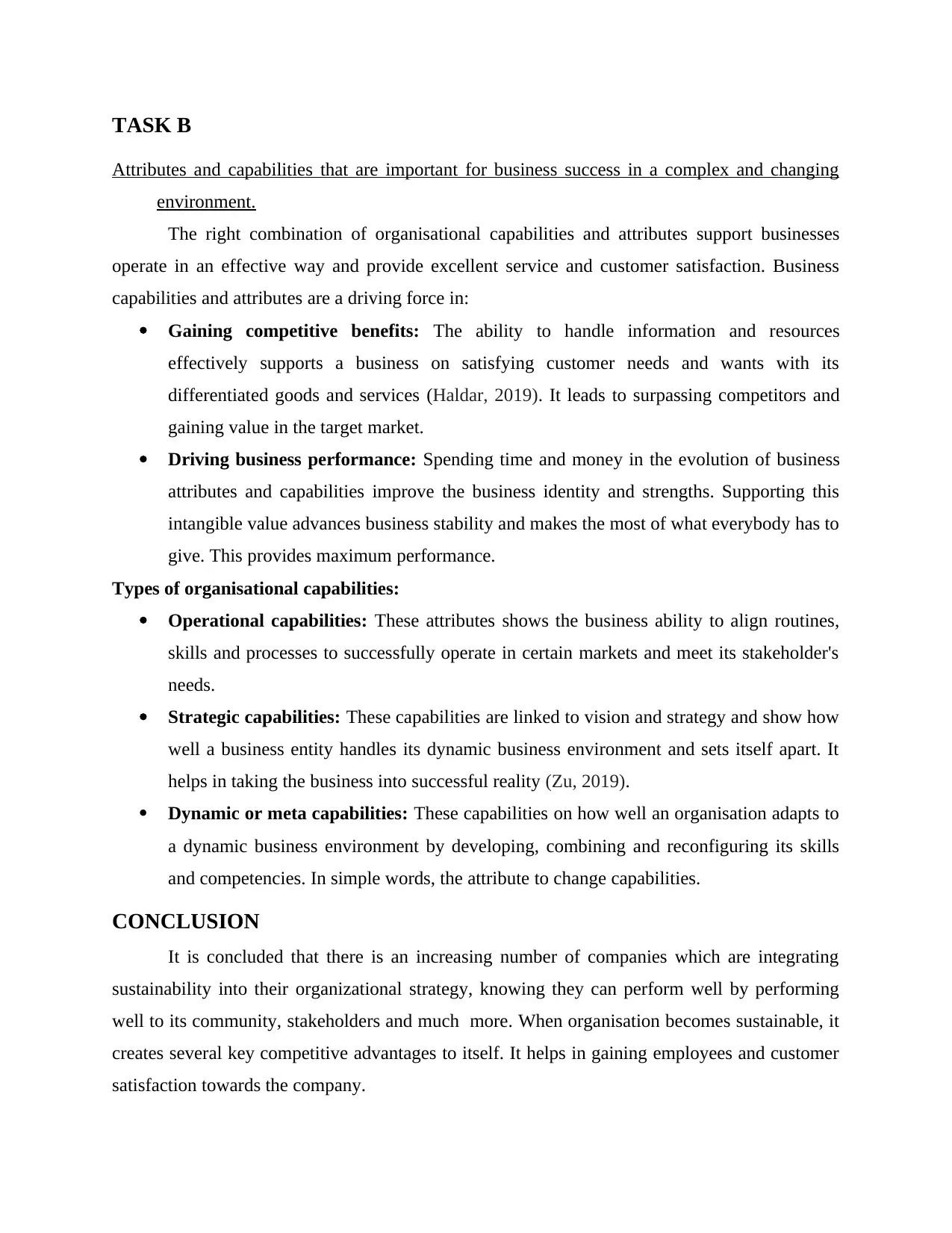
TASK B
Attributes and capabilities that are important for business success in a complex and changing
environment.
The right combination of organisational capabilities and attributes support businesses
operate in an effective way and provide excellent service and customer satisfaction. Business
capabilities and attributes are a driving force in:
Gaining competitive benefits: The ability to handle information and resources
effectively supports a business on satisfying customer needs and wants with its
differentiated goods and services (Haldar, 2019). It leads to surpassing competitors and
gaining value in the target market.
Driving business performance: Spending time and money in the evolution of business
attributes and capabilities improve the business identity and strengths. Supporting this
intangible value advances business stability and makes the most of what everybody has to
give. This provides maximum performance.
Types of organisational capabilities:
Operational capabilities: These attributes shows the business ability to align routines,
skills and processes to successfully operate in certain markets and meet its stakeholder's
needs.
Strategic capabilities: These capabilities are linked to vision and strategy and show how
well a business entity handles its dynamic business environment and sets itself apart. It
helps in taking the business into successful reality (Zu, 2019).
Dynamic or meta capabilities: These capabilities on how well an organisation adapts to
a dynamic business environment by developing, combining and reconfiguring its skills
and competencies. In simple words, the attribute to change capabilities.
CONCLUSION
It is concluded that there is an increasing number of companies which are integrating
sustainability into their organizational strategy, knowing they can perform well by performing
well to its community, stakeholders and much more. When organisation becomes sustainable, it
creates several key competitive advantages to itself. It helps in gaining employees and customer
satisfaction towards the company.
Attributes and capabilities that are important for business success in a complex and changing
environment.
The right combination of organisational capabilities and attributes support businesses
operate in an effective way and provide excellent service and customer satisfaction. Business
capabilities and attributes are a driving force in:
Gaining competitive benefits: The ability to handle information and resources
effectively supports a business on satisfying customer needs and wants with its
differentiated goods and services (Haldar, 2019). It leads to surpassing competitors and
gaining value in the target market.
Driving business performance: Spending time and money in the evolution of business
attributes and capabilities improve the business identity and strengths. Supporting this
intangible value advances business stability and makes the most of what everybody has to
give. This provides maximum performance.
Types of organisational capabilities:
Operational capabilities: These attributes shows the business ability to align routines,
skills and processes to successfully operate in certain markets and meet its stakeholder's
needs.
Strategic capabilities: These capabilities are linked to vision and strategy and show how
well a business entity handles its dynamic business environment and sets itself apart. It
helps in taking the business into successful reality (Zu, 2019).
Dynamic or meta capabilities: These capabilities on how well an organisation adapts to
a dynamic business environment by developing, combining and reconfiguring its skills
and competencies. In simple words, the attribute to change capabilities.
CONCLUSION
It is concluded that there is an increasing number of companies which are integrating
sustainability into their organizational strategy, knowing they can perform well by performing
well to its community, stakeholders and much more. When organisation becomes sustainable, it
creates several key competitive advantages to itself. It helps in gaining employees and customer
satisfaction towards the company.
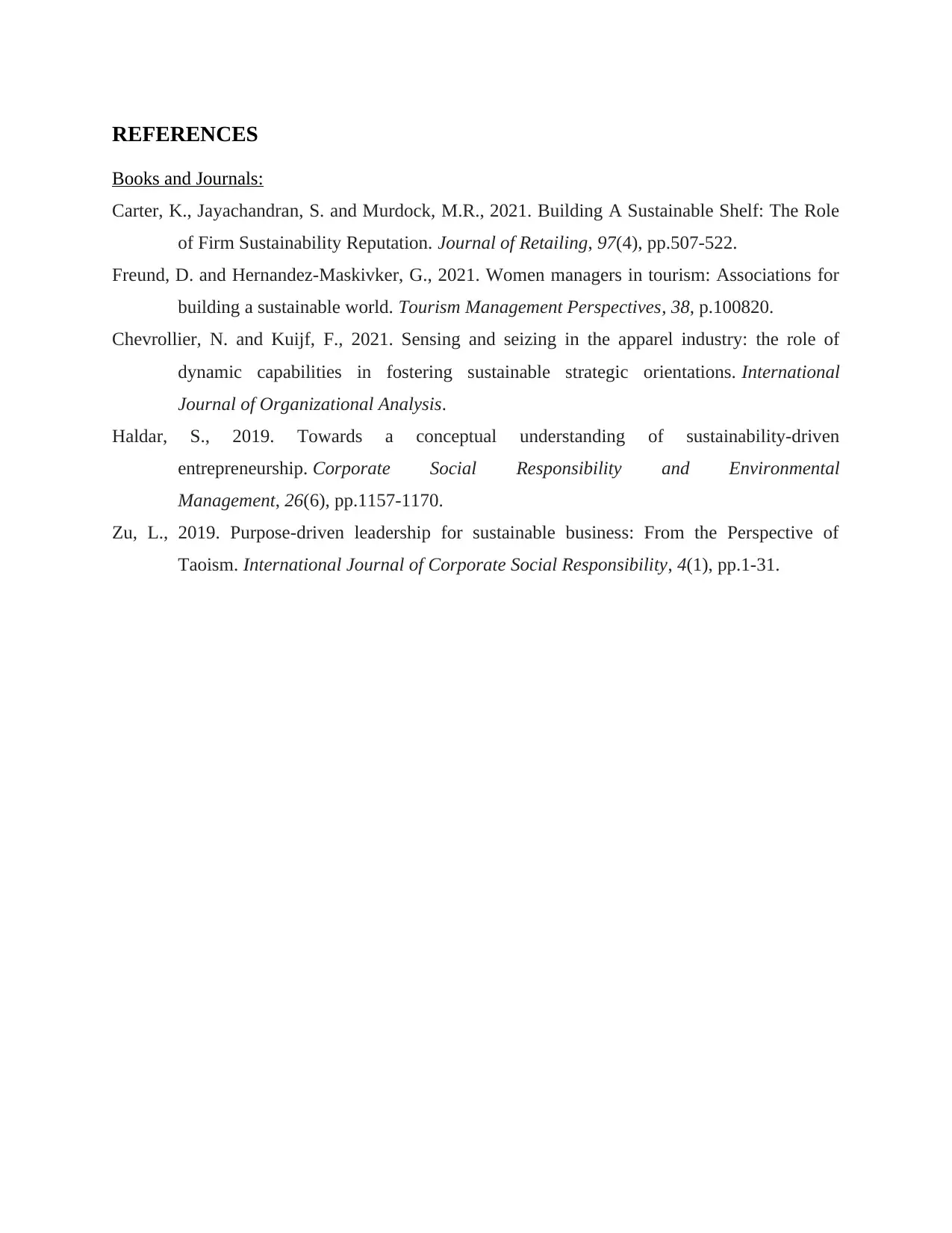
REFERENCES
Books and Journals:
Carter, K., Jayachandran, S. and Murdock, M.R., 2021. Building A Sustainable Shelf: The Role
of Firm Sustainability Reputation. Journal of Retailing, 97(4), pp.507-522.
Freund, D. and Hernandez-Maskivker, G., 2021. Women managers in tourism: Associations for
building a sustainable world. Tourism Management Perspectives, 38, p.100820.
Chevrollier, N. and Kuijf, F., 2021. Sensing and seizing in the apparel industry: the role of
dynamic capabilities in fostering sustainable strategic orientations. International
Journal of Organizational Analysis.
Haldar, S., 2019. Towards a conceptual understanding of sustainability‐driven
entrepreneurship. Corporate Social Responsibility and Environmental
Management, 26(6), pp.1157-1170.
Zu, L., 2019. Purpose-driven leadership for sustainable business: From the Perspective of
Taoism. International Journal of Corporate Social Responsibility, 4(1), pp.1-31.
Books and Journals:
Carter, K., Jayachandran, S. and Murdock, M.R., 2021. Building A Sustainable Shelf: The Role
of Firm Sustainability Reputation. Journal of Retailing, 97(4), pp.507-522.
Freund, D. and Hernandez-Maskivker, G., 2021. Women managers in tourism: Associations for
building a sustainable world. Tourism Management Perspectives, 38, p.100820.
Chevrollier, N. and Kuijf, F., 2021. Sensing and seizing in the apparel industry: the role of
dynamic capabilities in fostering sustainable strategic orientations. International
Journal of Organizational Analysis.
Haldar, S., 2019. Towards a conceptual understanding of sustainability‐driven
entrepreneurship. Corporate Social Responsibility and Environmental
Management, 26(6), pp.1157-1170.
Zu, L., 2019. Purpose-driven leadership for sustainable business: From the Perspective of
Taoism. International Journal of Corporate Social Responsibility, 4(1), pp.1-31.
⊘ This is a preview!⊘
Do you want full access?
Subscribe today to unlock all pages.

Trusted by 1+ million students worldwide
1 out of 6
Related Documents
Your All-in-One AI-Powered Toolkit for Academic Success.
+13062052269
info@desklib.com
Available 24*7 on WhatsApp / Email
![[object Object]](/_next/static/media/star-bottom.7253800d.svg)
Unlock your academic potential
Copyright © 2020–2025 A2Z Services. All Rights Reserved. Developed and managed by ZUCOL.



